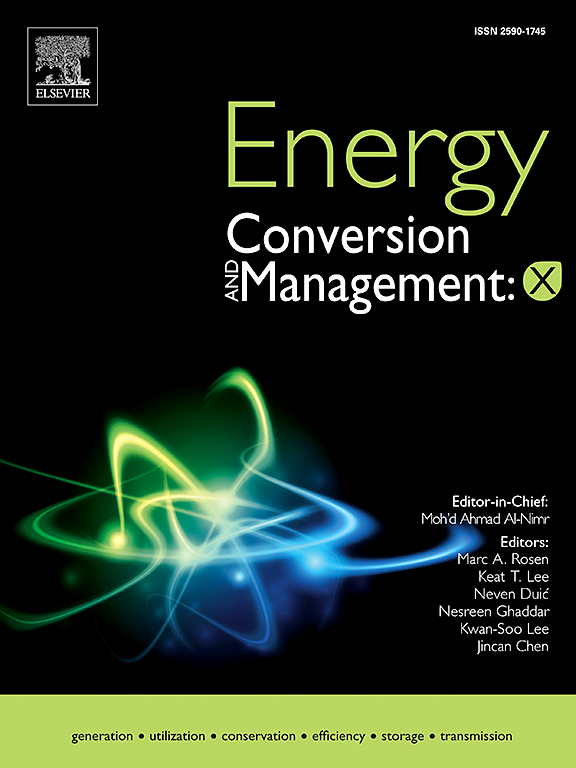不同氢共燃速率下天然气联合循环的性能评价
IF 10.9
1区 工程技术
Q1 ENERGY & FUELS
引用次数: 0
摘要
氢是一种很有前途的无碳燃料,用于减少发电过程中的二氧化碳排放,并且越来越多地被集成到燃气轮机联合循环(GTCC)系统中。本研究通过分析固定涡轮入口温度(TIT)和固定燃气轮机(GT)输出两种理想运行情景,评估了600兆瓦级GTCC电厂在氢共燃条件下的热性能,并提出了保持GTCC总输出恒定的负荷跟随策略。采用过程模拟模型评估了三种环境条件下氢气混合对GT性能、烟气成分和底部循环(包括热回收蒸汽发生器(HRSG)和汽轮机(ST))的影响。氢共烧带来了性能上的权衡:由于良好的燃烧特性,GT效率得到了提高,而由于HRSG传热性能下降,ST输出降低。在固定的TIT情景下,GT效率增加而ST输出略有减少。相比之下,在固定GT输出下,TIT和涡轮出口温度(TET)下降,显著降低了蒸汽温度和ST输出,特别是在高混氢比下。最大的性能下降发生在最低的TIT条件下。为了解决这种权衡问题,开发了一个额外的方案,通过调节TIT来调整GT/ST功率分配并保持恒定的GTCC输出。这种方法使热效率提高了0.72个百分点。该模型结合了辐射和对流传热机制,并捕捉了富氢燃烧气体的关键热物理效应,为氢共烧条件下GTCC稳定高效运行提供了实际见解。本文章由计算机程序翻译,如有差异,请以英文原文为准。

Performance evaluation of the natural gas combined cycle with various hydrogen co-firing rates
Hydrogen is a promising carbon-free fuel for reducing CO2 emissions in power generation and is increasingly being integrated into gas turbine combined cycle (GTCC) systems. This study evaluates the thermal performance of a 600-MWe-class GTCC plant under hydrogen co-firing by analyzing two idealized operational scenarios—fixed turbine inlet temperature (TIT) and fixed gas turbine (GT) output—and additionally proposes a load-following strategy that maintains constant total GTCC output. A process simulation model was used to assess the impact of hydrogen blending on GT performance, flue gas composition, and the bottoming cycle—including the heat recovery steam generator (HRSG) and steam turbine (ST)—under three ambient conditions.
Hydrogen co-firing introduced a performance trade-off: GT efficiency improved due to favorable combustion properties, while ST output decreased owing to degraded HRSG heat transfer. Under the fixed TIT scenario, GT efficiency increased with minor reductions in ST output. In contrast, under fixed GT output, TIT and turbine exit temperature (TET) declined, significantly reducing steam temperature and ST output, especially at high hydrogen blending ratios. The greatest performance degradation occurred under the lowest TIT condition. To address this trade-off, an additional scenario was developed by regulating TIT to adjust the GT/ST power split and maintain constant GTCC output. This approach resulted in thermal efficiency gains of up to 0.72 percentage points. The proposed model incorporates radiative and convective heat transfer mechanisms and captures the key thermophysical effects of hydrogen-rich combustion gas, offering practical insights for stable and efficient GTCC operation under hydrogen co-firing conditions.
求助全文
通过发布文献求助,成功后即可免费获取论文全文。
去求助
来源期刊

Energy Conversion and Management
工程技术-力学
CiteScore
19.00
自引率
11.50%
发文量
1304
审稿时长
17 days
期刊介绍:
The journal Energy Conversion and Management provides a forum for publishing original contributions and comprehensive technical review articles of interdisciplinary and original research on all important energy topics.
The topics considered include energy generation, utilization, conversion, storage, transmission, conservation, management and sustainability. These topics typically involve various types of energy such as mechanical, thermal, nuclear, chemical, electromagnetic, magnetic and electric. These energy types cover all known energy resources, including renewable resources (e.g., solar, bio, hydro, wind, geothermal and ocean energy), fossil fuels and nuclear resources.
 求助内容:
求助内容: 应助结果提醒方式:
应助结果提醒方式:


